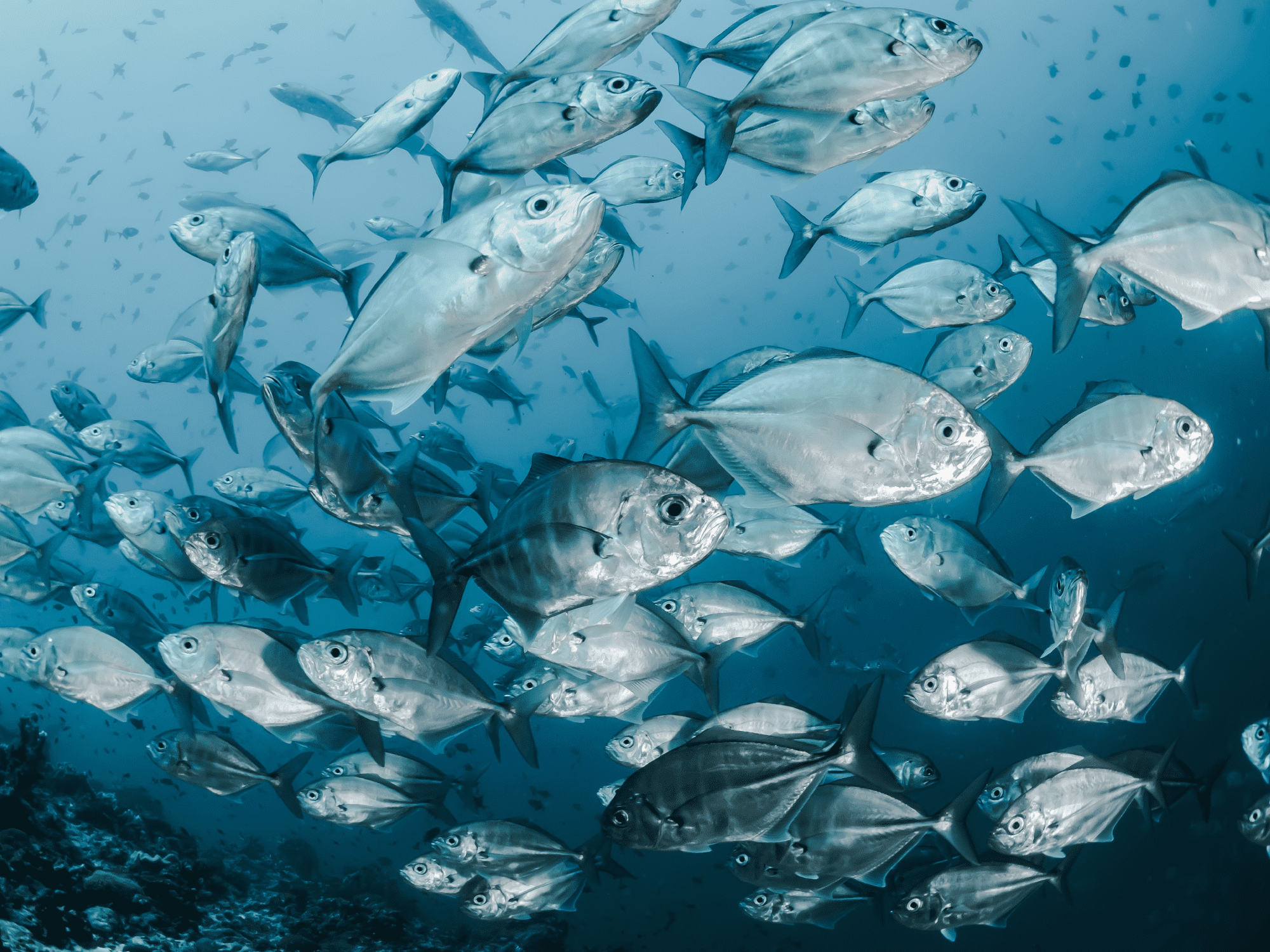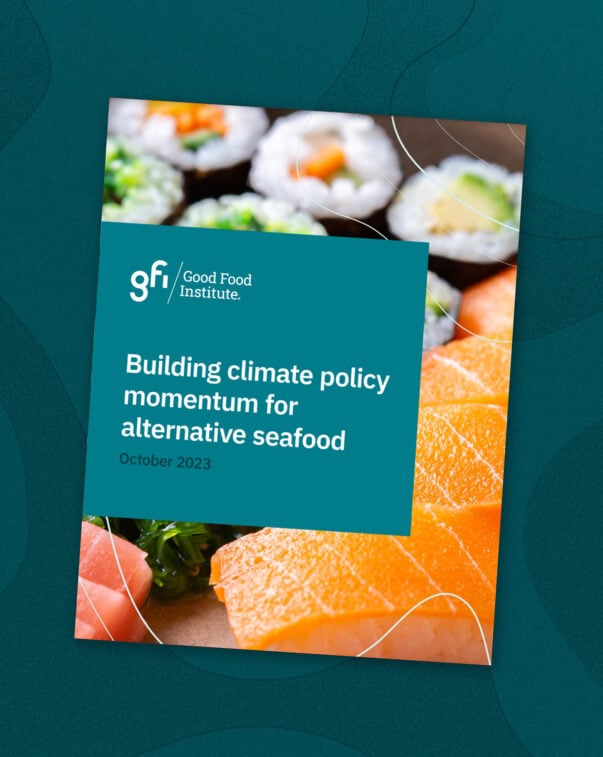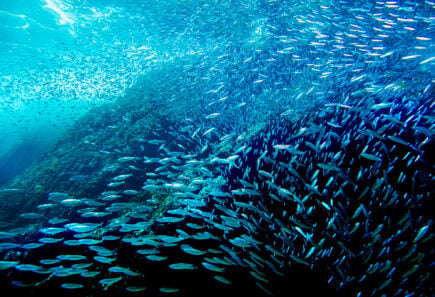
The climate benefits of accelerating global production of alternative seafood
This white paper explores how plant-based and cultivated seafood could fill the growing seafood supply gap while reducing emissions associated with conventional seafood production. It details opportunities for policymakers and ocean advocates to advance alternative seafood in service of a climate-friendly and resilient seafood supply chain and healthy ocean ecosystem.
Read our white paper brief
Alternative seafood could drive major climate benefits
Seafood is a significant source of animal protein—globally eaten twice as often as poultry and three times as often as beef.1 By 2030, global seafood production is expected to grow by 14 percent.2 Neither wild-capture fishing nor fish farming can scale to meet growing demand without threatening the health of the ocean and rivers.
Scaling plant-based and cultivated seafood could mitigate the climate impacts of global seafood consumption and reduce harm to sensitive aquatic ecosystems.
Plant-based seafood may be particularly important for meeting near-term climate goals given how efficiently plants produce high-value protein. The global adoption of a plant-rich diet provides a 50 percent chance of meeting the Paris goal to prevent a 1.5-degree increase in global temperatures relative to pre-industrial levels.3
Cultivated seafood—if scaled using renewable energy—represents a low-emission alternative to many forms of seafood. Made to match the sensory and nutritional profile of conventional seafood, cultivated seafood can also ease and accelerate consumer shifts toward climate-friendly diets.
This white paper unpacks what is known about the emissions of conventional and alternative seafood production and explores how policymakers and ocean advocates can advance alternative seafood to build a diversified, climate-smart, nature-positive seafood supply chain.
How alternative seafood could help mitigate climate impacts
The research landscape for assessing the emissions of both conventional and alternative seafood is not yet mature. For instance, only a limited number of studies compare conventional seafood and other center-of-the-plate proteins to alternative proteins.4 Scientific methods vary by study, and few researchers have examined impacts across the full value chain from production to consumption.
Nonetheless, current research indicates that plant-based and cultivated products could be important strategies for meeting the global appetite for seafood while minimizing emissions. At a high level:
- Plant-based alternatives have a greenhouse gas (GHG) footprint one-third less than conventionally farmed fish and three-quarters less than farmed crustaceans.
- Cultivated meat using conventional energy sources will have emissions greater than most farmed and most wild seafood products but less than the most-emissions intensive conventional seafood. Scaling renewable energy will substantially decrease cultivated meat emissions, making cultivated meat a low emissions alternative in the lower range of emissions from farmed fish and less than the emissions of most wild fish.
- Cultivated seafood is likely to require less energy than cultivated red meat and poultry, in large part because seafood can be cultivated at lower temperatures than terrestrial meats.5
Climate advocates, leaders in sustainable seafood, and policymakers have the opportunity to leverage alternative seafood as a core strategy for decreasing emissions while building a resilient global food system decoupled from ecosystem harm (see GFI’s companion white paper focused on biodiversity benefits of alternative seafood). Advancing alternative seafood as a climate and biodiversity solution may also help address other global challenges including nutrition, public health, and food security.
“Seafood is a significant source of animal protein, globally eaten twice as often as poultry and three times as often as beef.”
Béné, Christophe, Manuel Barange, Rohana Subasinghe, Per Pinstrup-Andersen, Gorka Merino, Gro-Ingunn Hemre, and Meryl Williams. “Feeding 9 Billion by 2050 – Putting Fish Back on the Menu.”
Alternative seafood can strengthen ocean conservation policies and programs
Plant-based and cultivated seafood are less developed commercial and research landscapes than those of terrestrial meat alternatives. To realize the potential climate benefits of alternative proteins and bolster a climate-friendly, nature-positive, and resilient seafood supply, policymakers and ocean advocates can:
- Increase public investment in relevant research to advance alternative seafood and recognize such initiatives as climate and biodiversity solutions.
- Ensure a clear, efficient regulatory path to market: alternative seafood should not be subject to regulatory requirements that exceed the norms for conventional proteins.
- Level the playing field for alternative seafood producers for a fair, competitive marketplace with equitable labeling laws for all types of protein, including alternative meat and seafood.
- Increase investment in research that quantifies how various forms of seafood production affect sequestration, GHG releases, and warming potential.
Alternative seafood has the potential to provide healthy, geographically distributed, and nutritionally dense protein while relieving pressure on ocean ecosystems in the face of human population growth. Download the white paper to learn more about how plant-based and cultivated seafood may mitigate emissions and how policymakers, nonprofits, and others can advance this emerging sector.

Download the full white paper
Explore the complete white paper Climate benefits of accelerating global production of alternative seafood.
Related resources

The biodiversity benefits of alternative seafood
This paper explores how plant-based and cultivated seafood could fill the growing supply gap while minimizing impacts on biodiversity.

Sustainable Seafood Initiative
Learn how plant-based, fermentation-derived, and cultivated seafood can improve the health and sustainability of oceans.

Action paper: An ocean of opportunity
This action paper explores alternative seafood’s role in creating a sustainable, secure, and just food system.

Industry Update: Alternative seafood
Join us for an event series covering the current global landscape of alternative proteins. This webinar will provide a global analysis of the rapidly-developing alternative seafood industry.
References
1. Béné, Christophe, Manuel Barange, Rohana Subasinghe, Per Pinstrup-Andersen, Gorka Merino, Gro-Ingunn Hemre, and Meryl Williams. “Feeding 9 Billion by 2050 – Putting Fish Back on the Menu.” Food Security 7, no. 2 (April 2015): 261–74. https://doi.org/10.1007/s12571-015-0427-z.
2. FAO, “The State of World Fisheries and Aquaculture 2022. Towards Blue Transformation.” Rome: FAO, 2022. https://doi.org/10.4060/cc0461en.
3. Clark, Michael A., Nina G. G. Domingo, Kimberly Colgan, Sumil K. Thakrar, David Tilman, John Lynch, Inês L. Azevedo, and Jason D. Hill. “Global Food System Emissions Could Preclude Achieving the 1.5° and 2°C Climate Change Targets.” Science 370, no. 6517 (November 6, 2020): 705–8. https://doi.org/10.1126/science.aba7357.
4. The term “alternative proteins” is broadly construed to include all plant-based and cultivated center-of-the-plate products that have a comparable culinary use and sensory profile to conventional meat and seafood products. While most products in this category provide high protein content as well, some, such as those made from mushroom or jackfruit, do not.
5. Rubio, Natalie, Isha Datar, David Stachura, David Kaplan, and Kate Krueger. “Cell-Based Fish: A Novel Approach to Seafood Production and an Opportunity for Cellular Agriculture.” Frontiers in Sustainable Food Systems 3 (June 11, 2019): 43. https://doi.org/10.3389/fsufs.2019.00043.
